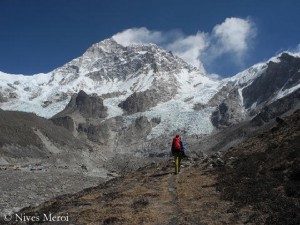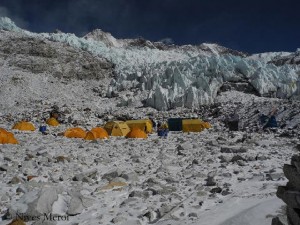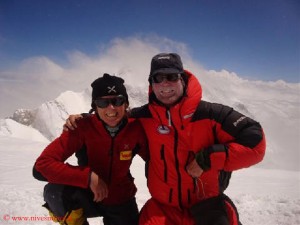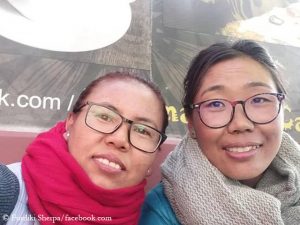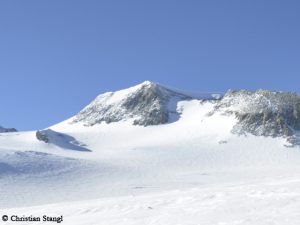Nives Meroi: “The arrogance of commercial climbing”
One eight-thousander is still missing. Then Nives Meroi and Romano Benet would be the first couple who would have scaled together the 14 highest mountains in the world – always without bottled oxygen and without Sherpa support. On 12 May, the two 54-year-olds from Italy stood at the top of their eight-thousander No. 13, the 8485-meter-high Makalu in Nepal.
Nives was 19 years old when she met Romano. First he was her climbing partner, then her life partner. They are married for 27 years. In 1998, they scaled Nanga Parbat, it was their first eight-thousander. In 2003, they succeeded in climbing the Karakorum trilogy of Gasherbrum I, II and Broad Peak in just 20 days. In 2007, Meroi was the first Italian woman who climbed Everest without oxygen mask.
Life-threatening disease
But there were also setbacks. In 2009, Meroi had a good chance to become the first woman on all 14 eight-thousanders. On Kangchenjunga, at 7500 meters, Romano suddenly became increasingly weak. He tried to persuade Nives to climb on alone. But she refused and supported him during the descent. The reason for Benet’s weakness was serious: aplastic anemia. Two bone marrow transplants were necessary to save Romano’s life. They returned to the Himalayas. In 2014, Romano and Nives climbed Kangchenjunga. And now Makalu. Five questions to and five answers by Nives Meroi:
Nives, Romano and you have managed to climb Makalu, your 13th eight-thousander. If you compare it with the other twelve, was it rather one of the more difficult or easier ascents?
Technically, apart from the last 500 to 600 meters below Makalu-La (saddle at 7,400 m on the normal route), it is not very difficult and in addition the conditions in the wall were good. The problem was mainly the wind, which forced us to stay at Base Camp for a long time, and the cold, which caused slight frostbite at my toes.
It was your third attempt on Makalu after one in fall 2007 and another in winter 2007/2008. Now you tried it in spring, and you were successful. Was it the secret of success to take this season of year?
In fall 2007, Romano and I were the only expedition on Makalu. Upon our arrival, a disturbance had dumped two meters of snow onto the Base Camp. Breaking trail again and again, we reached Makalu-La, but it was too late. While trying to climb to the top, the jet stream arrived and forced us to climb down.
In contrast, in winter 2007/2008 the sky was clear and the conditions in the wall were exceptional, but the wind, with gusts up to 100 km/ h at Base camp, prevented us from climbing. There were only two days in a month without wind and we managed to climb up almost to Makalu-La. But on 9 February, a strong gust destroyed our Base Camp. I was torn from the ground and broke my ankle. My two companions, Romano and Luca (Vuerich; he died in 2010), carried me for two days on their shoulders along the glacier to Hillary Camp, from where we were rescued by helicopter.
Climbing an eight-thousander, you also need luck with the weather!
This spring, there were also some commercial expeditions on the mountain. You and Romano are always climbing without bottled oxygen and Sherpa support. Was it difficult for you to arrange with these teams?
Yes, from year to year more energy must be wasted at Base Camp to defend ourselves from the overbearing attitude and the arrogance of commercial climbing.
In your book, that was recently published in German, you describe Romano’s disease, aplastic anemia, as the “15th eight-thousander” that you had to climb. In which way has this experience changed your and Romano`s perspective?
After a first period, when he was angry about the years which, according to him, the illness had “stolen” from him, Romano is taking it now more dispassionate. I perhaps have become more anxious, the memory of the disease still frightens me.
Now there is only Annapurna left to complete the 14 eight-thousanders. Taking the fatality rate into account, it’s the most dangerous eight-thousander. How do you assess the difficulty of this climb and when do you want to try it?
We prefer to make no plans. We’ll see if we get a chance, physically and economically. This would be our third attempt. The first time, in 2006, we tried it from the north, the second time, in 2009, from the south and in both cases we abandoned our attempts because the conditions were too dangerous.
I and Romano are experts in the “art of escape without shame”, and if we return there, we’ll face it again this way.



